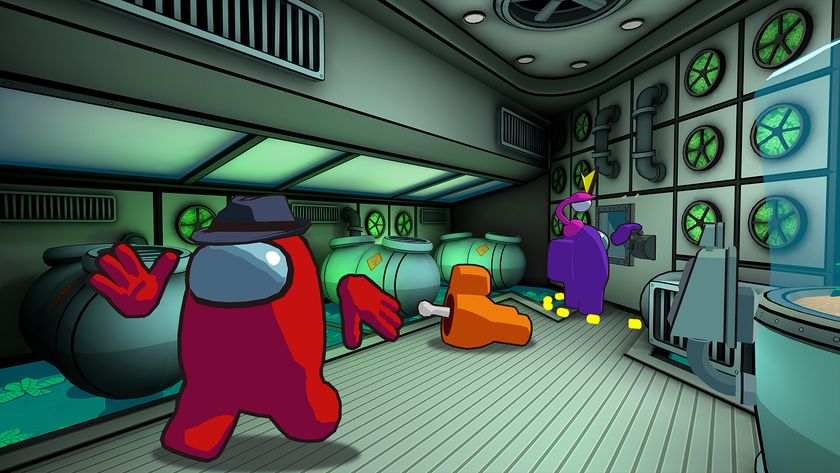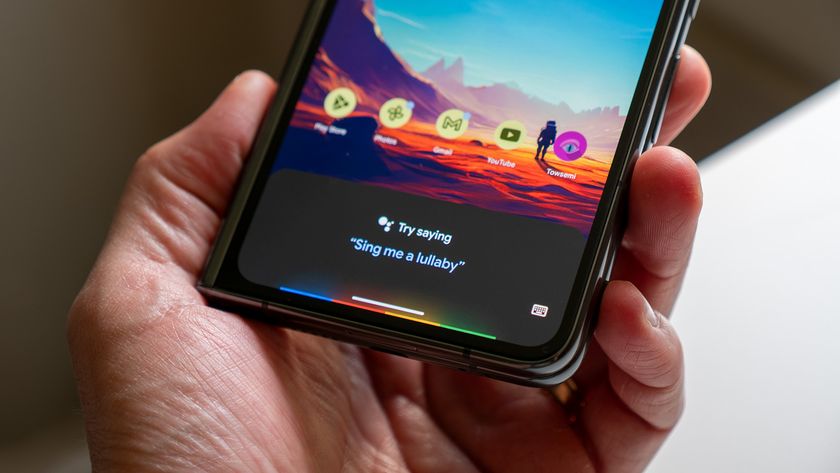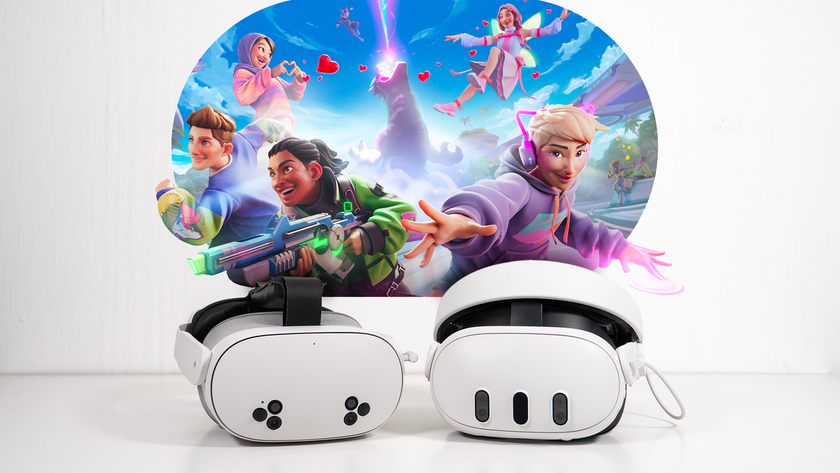Toshiba Thrive 7 review
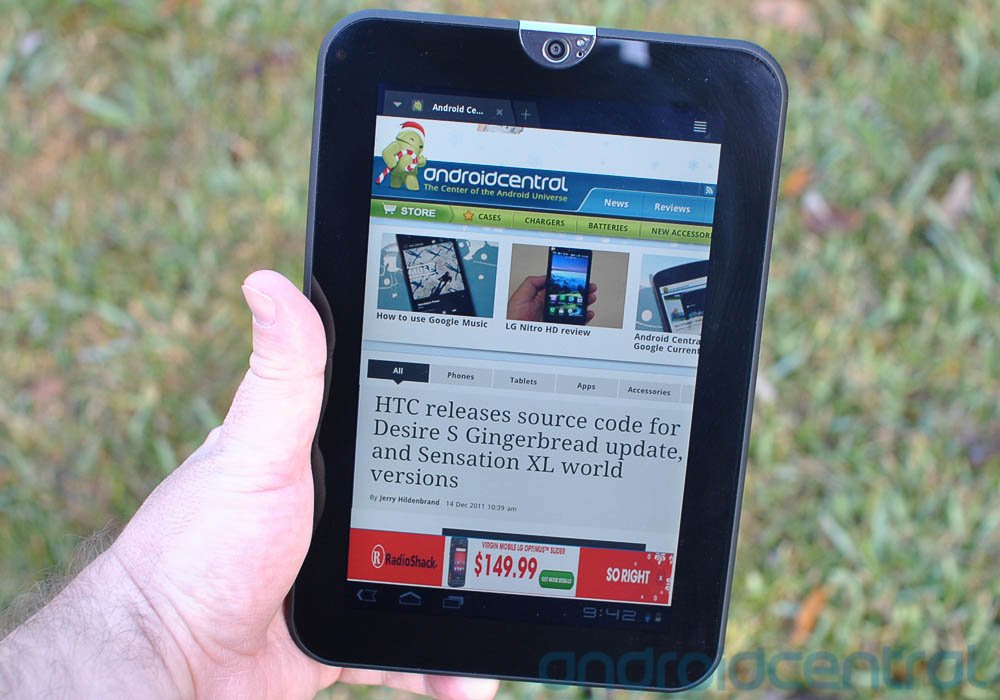
In the vast sea of Android tablets, it can take a bit to stand out. Toshiba managed to do so with the original Thrive tablet thanks to a bevy of full-size ports that no other tablet saw fit to include. On the other hand, a good many other Android tablets are thinner and lighter, too. But the Thrive bucked that trend and gained a decent following.
The Toshiba Thrive 7, as its name implies, scales things down a bit. Gone is the 10-inch display, trading it in for a 7-inch display. It's not terribly svelte, but neither is it horribly heavy, and Toshiba's seen fit to include a good number of ports and features unseen on other tablets. But it's also got a couple of quirks that have left us banging our heads against the tablet.
Head on past the break for our complete Toshiba Thrive 7 review.
Pros
- We're loving the 7-inch size, and the screen and its 1280x800 resolution are excellent. Tegra 2 performs as well as ever.
Cons
- A bit of a big bezel, a bit pricey when compared to the e-reader tablets, and the rear camera is pretty horrid.
The Bottom Line
As far as 7-inch tablets go, you could do worse, we suppose. It's fast, the display is great, and so long as you don't intend on taking many pictures, you could find yourself plenty happy with the Thrive 7
Be an expert in 5 minutes
Get the latest news from Android Central, your trusted companion in the world of Android
The video hands-on
Youtube link for mobile viewing
The hardware
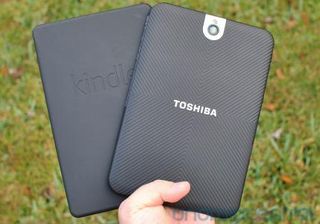
If you had to pick one other tablet to compare the Thrive 7 to, it'd be the Amazon Kindle Fire. Both are about the same size and thickness (the Thrive is 0.47 inches thick), though the Thrive 7's a little more friendly with rounded corners.
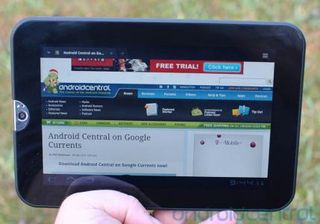
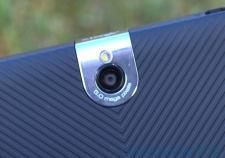
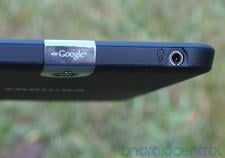
The front of the Thrive's devoid of any visible buttons, as is the Honeycomb/Ice Cream Sandwich way. It's got a 2MP front-facing camera on one of the short ends, highlighted by a silver band that wraps around to the rear 5MP camera and flash on the back, a "With Google" logo nicely tucked onto the bezel. There's a hidden notification light tucked into the corner to the left (or below) the front-facing camera. It pulses when you've got a notification and is bright without being annoying.
The display itself is fairly impressive. It's got a 1280x800 resolution with 16:10 aspect ratio. On a display that's just 7 inches, it's certainly noticeable, considering most other tablets that size have a lower resolution. Taking away from that, however, is a fairly thick bezel. It's not any thicker than we're used to seeing on other tablets. But proportionally, it stands out a little.
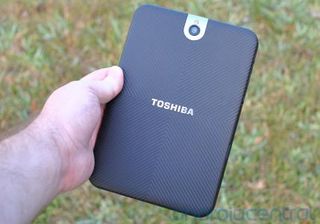
The rear of the Thrive 7 is done up in the same grooved pattern of the original Thrive 10, with the points meeting in a V on the axis extending from the center, with the Toshiba logo resides. It's a nice, if not very subtle, design, and it gives a fair amount of grip to the tablet.
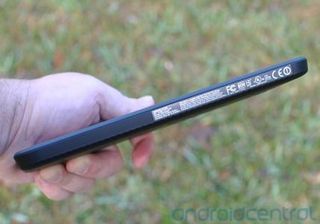
The bezels are where things get busy. One long end has the required FCC information glued on. The top edge has the aforementioned "With Google" logo and 3.5mm headphone jack.
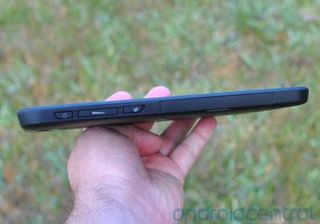
The other long edge has the power button, volume rocker and rotation lock switch. Just past that is a nicely hidden door.
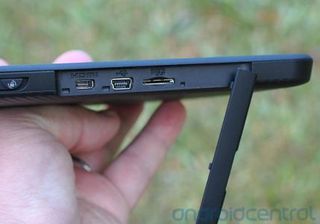
And behind that door is a microSD card slot micro HDMI port, and a mini USB port. No, that's not a typo. The Thrive 7 has a port for connecting to a computer that's largely been phased out over the past couple of years. Chances are you have one laying around somewhere, but that's not really the point. The majority of the free world has moved on to micro USB. Chances are, if you're reading this, you've got one within sight.
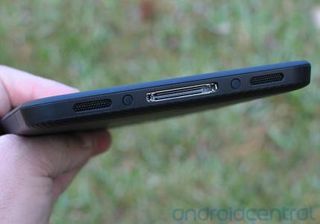
The bottom bezel's got a pair of speakers. We'd prefer to have them a little farther apart than you'll get form being on the short end of the device, but at least there are two. And they've got decent volume to them.
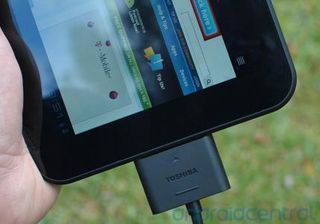
But the one feature we're hopelessly stuck on is the ridiculously oversized charging plug. We're used to seeing proprietary adapters on Android tablets, so much so that we've stopped complaining about them. But the size of the charging plug on the Thrive 7 is ridiculous. And oversized. And ridiculously oversized. When we first saw it, it reminded us of the giant plug from an Xbox 360. OK, it's not quite that big. But the damn thing's huge for a charging port. We're overreacting a little bit, we know. But we see a lot of chargers, and this thing is just huge.
What's under the hood
The internals of the Thrive 7 are nothing to sneeze at, but neither are they anything new. It's got a dual-core Tegra 2 system on a chip running at 1GHz, with 1GB of RAM, all running Android 3.2. (No word yet on an Ice Cream Sandwich update.) Tooling around the user interface was as quick as it's ever been, and the Thrive handled playing Netflix movies and the Need for Speed Shift demo just fine.
You've got two storage options -- 16GB or 32GB. The former keeps the Thrive 7 at a fairly respectable $379.99, while the latter bumps it up to a tougher-to-swallow $429.99.
Battery life's been decent enough with the 15Wh "Prismatic Lithium Ion Battery." Sure sounds fancy, don't it? The Thrive 7's going to be limited by its size here more than anything else. And unlike the original Thrive, this battery's not removable.
The software

We're not going to dive too much into this -- Honeycomb remains Honeycomb. The home screens are plain as they ever were. And with the rotation lock disengaged, they rotate as advertised, if a little slow.
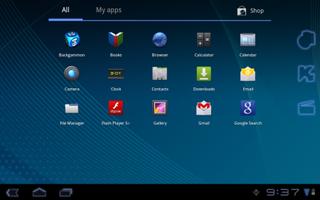
You've got all the usual Google apps, and Toshiba's thrown in some of its own, including Backgammon, Euchre, Hearts, Solitaire, Spades, Kaspersky Tablet Security, Netflix, NFS Shift, a mobile printer sharing app, Quickoffice HD, Service Station (for firmware updates) and a file manager. Nothing too out of the ordinary, and nothing we'd consider obsessive bloatware.
We had nary a problem with all our usual web pages, book reading and video playback. It's a Tegra 2 tablet, all right.
The cameras
We don't expect a whole lot from tablet cameras. It's an unwieldy platform for taking pictures in the first place. But for as low as we set that bar, the Thrive 7 managed to trip right over it.
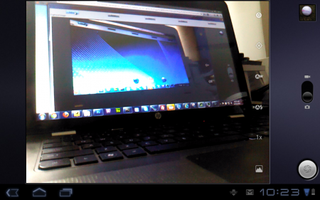
Let's not mince words here. The Thrive 7 has just about the worst shutter lag of any device we've seen. We're talking in the neighborhood of five second or so between the time you press the button and an image is taken. Forget about anything in low light -- that only makes it worse. Outdoors is OK, but as soon as you're out of natural light, the Thrive seems to have to consider whether it really wants to take the picture, and then figure out how to do it. On our initial shots, we'd already moved the tablet before realizing that the shutter had never triggered. Here's what we're talking about.
Youtube link for mobile viewing
Remember how bad the Motorola Droid Bionic's camera was at first? This is worse. The only redeeming factor is that image quality isn't horrible.
Images below open in full resolution in a new window




Video recording fares a little better -- or at least doesn't have the same problems. In fact, the 2-megapixel front-facing camera (which we'd argue is more important that the rear camera because of video calling) is quite good.
Youtube link for mobile viewing
Youtube link for mobile viewing
The wrap-up
So we've got another 7-inch tablet on our hands, and a decent one at that. But at the end of the day, it's just another 7-inch tablet, and a slightly pricey one at that, especially in a world of $200 Amazon Kindle Fires and $250 Nook Tablets. But you get what you pay for, mostly. And that'd be a full-fledged Android tablet (without any hackery), the likelihood of an upgrade to Ice Cream Sandwich, an excellent and full access to the Android Market. But the camera? Yeah. The camera. Not good.
Don't worry too much about us ranting about the horrendously oversized charging plug. We're paid to stay up nights thinking about these things. At the end of the day, it's a means to an end. Unless you're going to using it plugged in a lot, it's a minor (albeit still ugly) inconvenience.
If you're looking for a full Android tablet and want to keep price fairly low, the Thrive 7 is definitely worth your consideration, so long as you won't be taking pictures with it.

